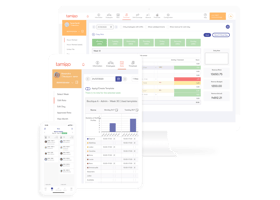Spreadsheets have been a staple of employee scheduling since the 90s. But now, their time is up! Workforce management (WFM) software offer retailers a smarter and more data-driven approach.
In this article, Jakob Toftgaard (tamigo founder and CEO) and Karin Mærsk-Møller (tamigo’s Head of Implementation) explain why upgrading makes sense.
The limits of spreadsheets for employee scheduling
As a bundled software on Windows, it's no suprise that Excel became the go-to way for many businesses to schedule staff.
Tried and trusted perhaps. But Excel (or Google Sheets) comes with plenty of inherent limitations.
For one thing, store managers spend way too much time filling them out. Spreadsheets also quickly become outdated or incorrect — one missing decimal point causes havoc!
For HQ, spreadsheets are siloed from broader reporting. The data they contain usually needs to be manually entered into another system before it yields any real insights.

The case for workforce management solutions
We’ve talked about spreadsheets and their drawbacks. So what’s the alternative?
More and more enterprise companies are turning to cloud-based workforce management (WFM) solutions or software. And it’s a trend that’s set to grow. Market Research Future predicts the WFM market will be worth USD 18.8 billion by 2026.
These solutions offer the chance to increase productivity and streamline processes through automation. Here’s Jakob and Karin to explain more.
1. Gain enterprise-wide transparency
Jakob: A big plus of a WFM solution is the transparency it grants you, across all your company’s departments.
With manual processes like spreadsheets, employees often have their own way of doing things. This can expose your business to the risk of human error or inaccurate data.
Let’s take an example. As a retail company, you identify productivity as your business’ most important KPI. However, your highest revenue stores don’t keep track of this in their spreadsheets because it’s not an issue for them. This missing data then completely throws off your wider reporting and planning.
But with a solution, all the information about planned shifts, actual worked hours, in-store productivity and employee data is in the cloud. HR, operations, area managers, store managers and counter managers can all instantly see when information is missing. Or when something doesn’t look right from a performance or productivity viewpoint.
Karin: It’s just a much more modern way of working. Employees can check their shifts on the go, and managers can approve sick leave with the touch of a button. If a store across the world needs additional resources, HQ can spot it.
2. Reduce errors and communication time
Jakob: Moving to a workforce management solution ensures that there is only ever one ‘true’ version of your store’s latest schedule in circulation. You avoid problems like someone editing an old file.
Karin: Yes, this ability to trust that your information is always up to date is hugely important. Changes made during the day are added to your latest version of the plan, and colleagues aren’t sending out drafts or the wrong spreadsheet.
This leads to another major benefit which is less time spent communicating changes.
With spreadsheets or even pen and paper, whenever you make an important change, you need to contact people to make sure they’ve seen it. In contrast, with a WFM solution, it’s all there in the ‘master view’ that everyone can access.
Employees can swap shifts in real-time digitally, while store managers give the final approval. And everything is visible to the employees, so there’s never confusion about who’s working when.
For a real-life case on how this works, check out our story on international sports brand Salomon. They adopted WFM software to optimise operations without sacrificing their family spirit.
3. Improve forecasting for more efficient planning
Karin: A solution can be a crystal ball. You can look at your current planning and answer questions like:
- What effects will this have on this store’s future?
- Does it impact our retail chain's productivity?
- Does it look like this department will achieve its targets?
You’re not left looking at a spreadsheet after the fact, wondering what could have been done differently. You have the insights to plan ahead and meet your organisation’s KPIs.
Jakob: And this forecasting functionality isn’t complicated. Just create a schedule and input the data that you already have within your organisation. It requires minimal effort as everything is automated. And just like that, you’ve gone from reactive to proactive.
Ready to say goodbye to Excels? Learn more about WFM's features and benefits here.





